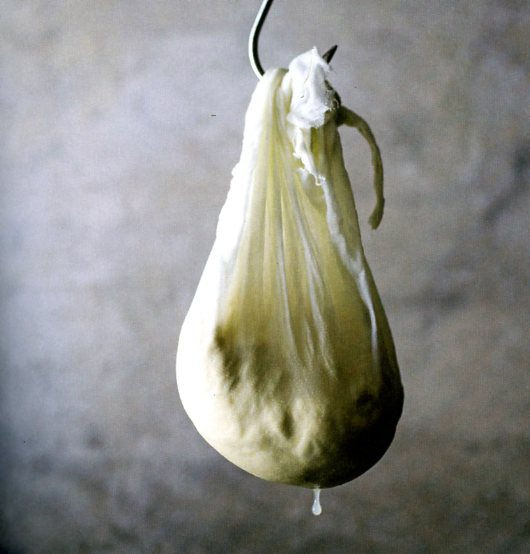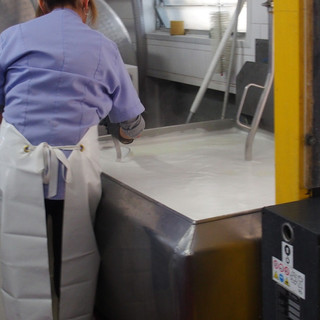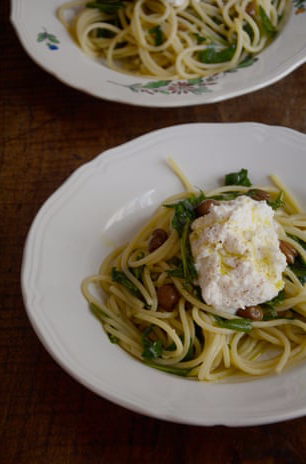Ricotta
- rosemarydearman1
- Oct 8, 2019
- 5 min read
"ricotta seems all the more precious because it is made from something that would otherwise be thrown away." Rachel Roddy

Back in 2014 we spent a week in Emilia Romagna about an hour south of both Bologna and Modena in a house just outside a tiny village called Coscogno. One day the Danish owner of the house took us down the hill to the nearby small town of Sant'Antonio where we watched, enthralled, a man and his wife make Parmigiano Reggiano. Once the Parmigiano was safely out of it's cooking vats and draining in huge moulds, the wife proceeded to a very large sink looking vat where she made ricotta. The picture above is the finished product. And below are a few of the actual process.
The man and his wife did this 365 days a year, twice a day. On their own. We were privileged to watch them at work. And of course we bought some of the finished product. Which was absolutely top notch.
Ricotta (which means recooked) is made from the whey that is left over from the Parmigiano Reggiano process. It is poured into this sink like structure, and heated to a bubbly froth. I think, having read about the process elsewhere that maybe some more milk and rennet was added but I can't quite remember now. However she did it, after a not very long period the whey - a thin creamy looking substance, separated yet again into more curds, which were then scooped out and poured into the little baskets above to drain. And that's how you make ricotta. I think we made a spinach and ricotta lasagne with the ricotta. The Parmigiano we just ate.
You can make your own from milk but:
"Ricotta made from whole milk is actually paneer. It isn't strictly a cheese as it hasn't gone through a fermentation process but is instead curdled milk which has been strained and hung." Nick Haddow
You need lots of whey to make ricotta, so unless you make lots of cheese you are not likely to have any. Which is why you can indeed resort to making it with milk. Just don't call it ricotta apparently. I found two slightly different recipes, both from the Guardian - one from the people at Honey & Co. and the second from Anna Jones. The main difference seems to be whether you use lemon juice or white vinegar to curdle the cheese. Nick Haddow and Anna Jones prefer vinegar, and I remember Madhur Jaffrey saying the same.
"I’ve tried lemon juice, but vinegar somehow produces more ricotta. The quantity of vinegar is key, too little and the curds won’t form properly; too much and the end result will taste like a chip shop." Anna Jones

Of course the longer you drain it the dryer it will become, and if you then add salt and keep it for a month or so, you will get ricotta salata which is another thing - more akin to feta but harder.
"With its ephemeral wobble, fresh ricotta is not an enduring food, especially in summer, so people have found ways of preserving it by salting. Traditionally done at home in dark corners with trays of salt, salted ricotta is now made on both a small and large scale. Lorena shows me how to rub a three-day old ricotta with salt until it is encrusted. After this, it will take a month, a second salting and careful draining for 500g of fresh ricotta to shrink into a round, ricotta salata a quarter of its original size.
The texture, too, is transformed – from soft to firm, and compact enough to be grated, or pared into crumbly-edged slices. Salting transforms the flavour, too: creamy and shy wobbles are given sharp, salty edges, with that sheepishness becoming more pronounced." Rachel Roddy
I see that That's Amore make a ricotta salata but I don't know if it is readily available. Maybe from a specialist deli, or the Queen Vic market. Or I saw somebody say that you could substitute feta.
But back to ricotta - why would you bother. Well over to Nigel Slater, who puts everything so beautifully.
"Ricotta barely makes it as a cheese. Traditionally made from the whey left behind after the curds that will become cheese are removed and start their journey to the maturing room, this is the lightest, gentlest-tasting dairy product, next to milk. It has no body to speak of, and can be spread like whipped cream.
I made myself a slice of thick toast, its crumb chewy, its crust as black as soot, then spread the surface with a snowy mound of ricotta and pieces of jelly-fleshed apricot. This treat never quite made it to the table and I ate it while standing at the kitchen counter. Then, a few minutes later, a second piece of bread, this time untoasted with a swirl of the ricotta, its crest pushed down into a hollow deep enough to hold a pool of olive oil. Unmediated, almost spontaneous. Eaten out of pure greed after coming home with a fresh loaf and white cheese as soft as cream." Nigel Slater
So too the folks at River Cottage who feature it as one of their favourite ingredients in the River Cottage A-Z book. Their introduction states that
"The good stuff has a delicate lactic, slightly 'cooked' flavour and the most wonderful texture - some is fluffy, soft and melt-in-the-mouth, while other varieties are a little firmer and beautifully crumbly, breaking obligingly into semi-soft nuggets that mingle beautifully into salads." Nikki Duffy
Their featured recipe is just pears, raw or poached sprinkled with crumbled ricotta, honey and thyme leaves. Simple but elegant. And talking of elegant, Donna Hay has dozens of recipes that use ricotta.
For it is so versatile. There are hundreds of recipes around. I had a quick look at the Coles Magazine and found two very simple ones - where the ricotta was simply crumbled and mixed in - and I am sure that you have come across this sort of usage over and over again. There's a pizza on the left and a salad on the right.
So to finish here are four slightly more complicated recipes: Baked blueberry, hazelnut and ricotta cake - from those people at Honey & Co. (I might make this one next time I have to make a cake), Baked ricotta with thyme from Nigel Slater, Spaghetti with rocket, anchovy and ricotta from Rachel Roddy, and Jamie Oliver's Swiss chard chips. The recipe for this last one is not online as it is in his very recent Jamie Cooks Italy book. Basically you roast the oiled leaves in the oven and then top with some ricotta whipped with lemon juice and zest, anchovy fillets and a pinch of chilli.
I'm writing about ricotta because I made spinach and ricotta gnocchi the other day - love them. And don't buy the prepackaged ricotta in the supermarket. Buy the fresh stuff from the deli. It might not be as good as the stuff from That's Amore and the like, but it's pretty good. I always buy the full fat version because I remember reading somewhere that this was better for cooking - but I could be wrong.
The only disadvantage of ricotta is that it doesn't keep very well. A few days maximum. So be careful how much you buy. If you have a little left over - like me - you can always make it into a dip by mixing with whatever you fancy.






























Comments